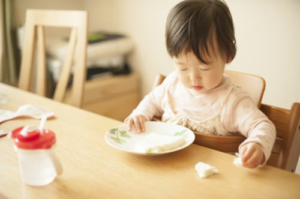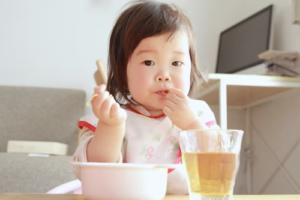I think there are many mothers who are worried about their children’s meals, such as “Does my child eat too much?” or “My child doesn’t eat much.” What is the ideal amount of food and nutritional balance for a 1-2 year old? This time, we have summarized the amount of food and nutritional balance for 1-2 year olds.
How much food should a 1 to 2 year old eat?
In Japan, the Ministry of Health, Labor and Welfare has set standards for food intake, known as dietary reference intakes. According to these standards, the recommended dietary intake for children aged 1 to 2 years is 950 kcal for boys and 900 kcal for girls. The
daily energy requirement for women aged 18 to 29 is 1650 to 2200 kcal, and for women aged 30 to 49, it is 1750 to 2300 kcal (this varies depending on physical activity level). Considering this, the amount of food required for a 1- to 2-year-old child is about half of the amount that a mother eats.
What is the nutritional balance for 1 to 2 year olds?

Even if you know that your child should only eat half the amount of food that their mother does, it’s no good if their nutritional balance is all over the place! So, I looked into the nutritional intake guidelines for children aged 1 to 2 years old.
Daily nutritional requirements for 1 to 2 year olds

- Protein: 15-20g
- Fat: 20-30g
- n-6 fatty acids: 5g
- n-3 fatty acids: 0.8g
- Carbohydrates: 50-65%
- Vitamin A: 250-440μg
- Vitamin D: μg
- Vitamin E: 3.5 mg
- Vitamin K: 60 µg
The percentage of carbohydrates refers to the percentage of total energy.
In addition to the above, the intake amounts of folic acid, vitamins B and C, etc. are also specified in detail, but since these are merely guidelines, you do not have to follow them every day, but if you are a mother who is concerned about your child’s nutritional balance, please refer to them.
This data is based on the “Dietary Reference Intakes for Japanese (2015 Edition)” published by the Ministry of Health, Labor and Welfare. If you would like to know more, please see the link below.
Let’s do our best without putting too much strain on Mom!

We have summarized the recommended amount of food and the nutritional needs of 1- to 2-year-olds. That being said, it can be quite difficult to prepare every meal properly. It is not good for the mother if cooking meals becomes a pain. We recommend that you do things well within the limits of your ability to not burden the mother, while
finding a good balance so that cooking meals is not a pain, such as “If you think there was a little less meat in the morning, then have a little more meat at lunch!” or “If there were few vegetables the day before, then have more vegetables today!”
